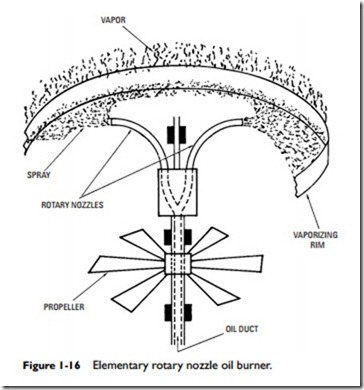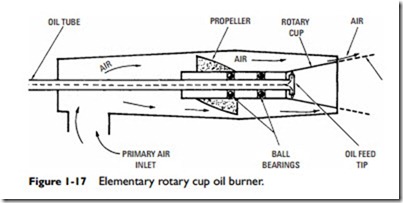Rotary Oil Burners
Rotary burners operate with low-pressure gravity and are available in a number of designs depending on the different conditions of use. In each case, the operating principle involves throwing the oil by centrifugal force.
Rotary oil burners can be classified either as rotary nozzle or rotary cup burners. The essential components of the rotary nozzle burner are shown in Figure 1-16. Air pressure acting on the pro-
peller causes the nozzle assembly to rotate at a very high speed. Oil is supplied through the hollow shaft to the nozzles, and the rotary motion causes the oil to be thrown off in a fine spray by centrifugal force. The flame from this spray heats up the metal vaporizing rim hot enough to vaporize the oil spray as it comes in contact with it. Being thoroughly mixed with air, a blue flame is produced. On some designs, the spray vaporized by the vaporizing rim is super- heated by passing through grilles.
The rotary cup oil burner (see Figure 1-17) contains a cone- shaped cup that rotates on ball bearings carried by a central tube. The fuel is supplied to the cup through this tube. In operation, drops of oil, issuing from the oil feed tip, come into contact with the cup as shown; by centrifugal force the drops are both flattened into a film and projected toward and off the rim of the cup, as shown in Figure 1-18. Because the rim is surrounded by a concentric
opening of the casing, the oil is met by the surrounding blast of primary air with which it mixes, giving the proper mixture for combustion.

